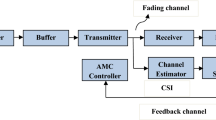Abstract
Certain widely used state-of-the-art, as well as newly suggested, types of signal modulation are studied. The proposed amplitude modulation of many components (AMMC) is characterized by a large Euclidean distance, higher noise immunity under the same maximum power and informativity of the modulated signal, or requires lower power of the modulated signal under the same noise immunity and informativity in comparison with the well-known amplitude shift keying (ASK), phase shift keying (PSK), and quadrature amplitude modulation (QAM). It is found that the technical efficiency of telecommunication systems and networks with limited bandwidth and signal power that use AMMC is overall higher in comparison with the other considered well-known types of modulation. In particular, 37-AMMC with 3 components is the most efficient type among the studied modulations with the number of symbols being up to 37.
Similar content being viewed by others
References
Proakis, J., Digital Communications, 4th ed., New York: McGraw-Hill, 2001.
Simon, M.K., Bandwidth-Efficient Digital Modulation with Application to Deep-Space Communications, Yuen, J.H., ed., California: Jet Propulsion Labor. California Inst. Technol., 2001.
Sklar, B., Digital Communications. Fundamentals and Applications, 2nd ed., Upper Sadle River, New Jersey: Prentice Hall, 2001.
Feher, K., Wireless Digital Communications. Modulation and Spread Spectrum Applications, Upper Sadle River, New Jersey: Prentice Hall, 1995.
Maghrebi, S.G., Lotfizad, M., and Ghanbari, M., A novel constellation with different noises in discrete multitone system, J. Appl. Sci., 2009, no. 9, pp. 1159–1164.
Dimitrov, S., Sinanovic, S., and Haas, H., Signal shaping and modulation for optical wireless communication, J. Lightwave Technol., 2012, vol. 30,Issue 9, pp. 1319–1328.
Yang, G., Satellite communication signal modulation which based on FDM, Proc. 2nd Int. Conf. on Information Engineering and Computer Science, Wuhan. 2010, pp. 1–4.
Dobkin, D.M., RF Engineering for Wireless Networks. Hardware, Antennas, and Propagation, Burlington: Elsevier, 2005.
Gorbatyy, I.V., Ukraine Patent 91950, Byull. Izobret., 2010, no. 17.
Teoriya elektricheskoi svyazi: Uchebnik dlya vuzov (Theory of Electrical Communication: A Handbook for High Education Institutes) Klovskii, D.D., Ed., Moscow: Radio Svyaz’, 1999.
Gorbatyy I.V. Research of information efficiency of amplitude modulation of many components, Visn. Nat. Univ. “L’vivs’ka politekhnika” 2010, no. 681, pp. 191–196.
Author information
Authors and Affiliations
Corresponding author
Additional information
Original Russian Text © I.V. Gorbatyy, 2014, published in Avtomatika i Vychislitel’naya Tekhnika, 2014, No. 1, pp. 63–75.
About this article
Cite this article
Gorbatyy, I.V. Investigation of the technical efficiency of state-of-the-art telecommunication systems and networks with limited bandwidth and signal power. Aut. Control Comp. Sci. 48, 47–55 (2014). https://doi.org/10.3103/S0146411614010039
Received:
Published:
Issue Date:
DOI: https://doi.org/10.3103/S0146411614010039




